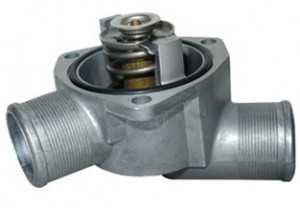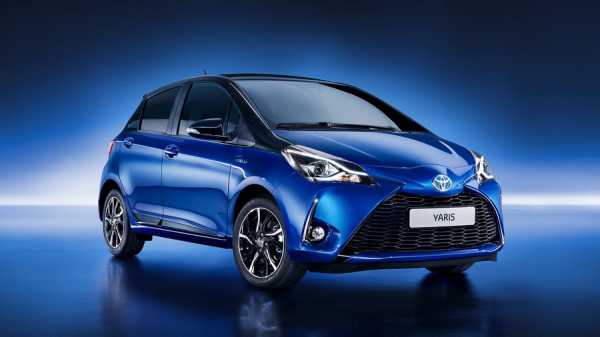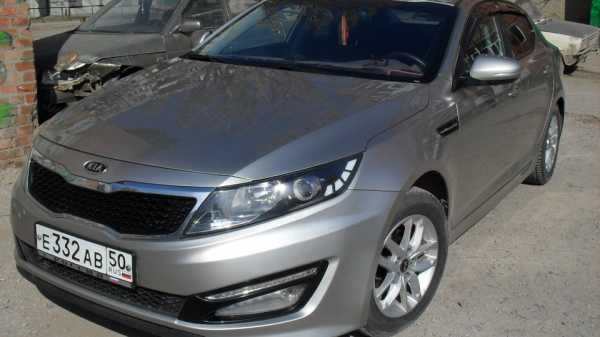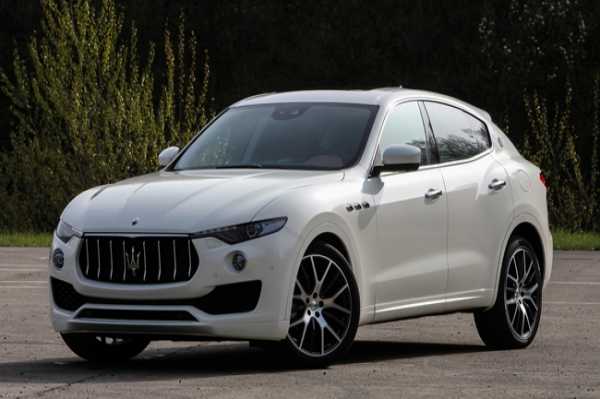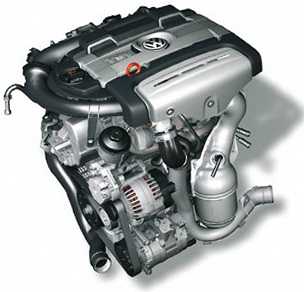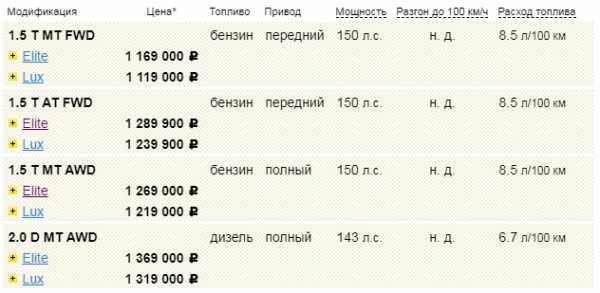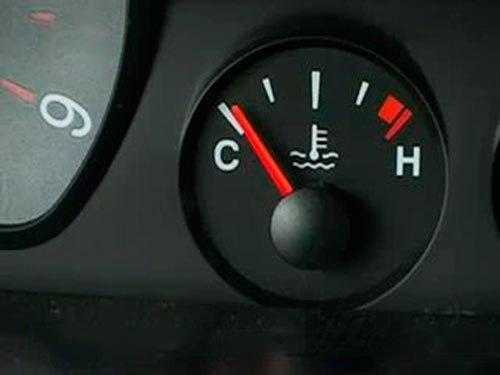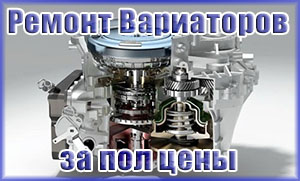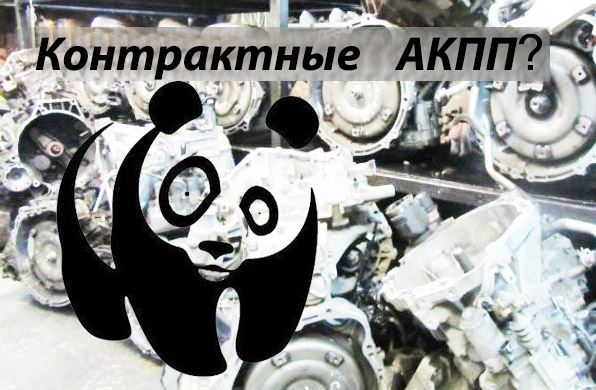Dodge challenger srt
2016 Dodge Challenger - Classic American Muscle Car
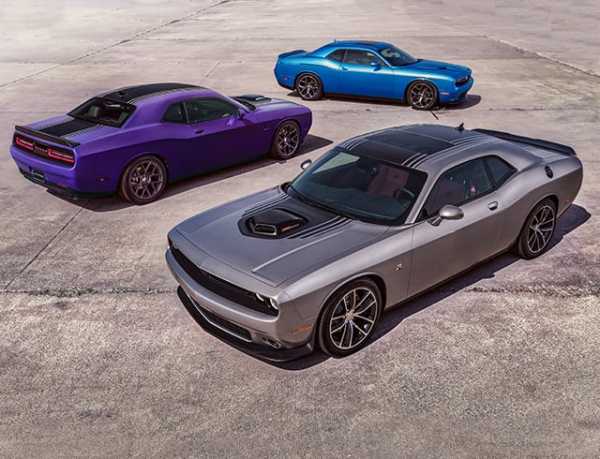
Challenger howls high performance. SXT Plus with the available SXT body-side stripe, 392 HEMI® Scat Pack SHAKER and R/T Plus SHAKER pictured here (shown in clockwise order from the top).
Challenger SXT Plus is available with a V6 body-side stripe. Shown in TorRed.
Challenger SRT® 392 includes 20x9.5-inch hyper black lightweight forged aluminum wheels with red brake calipers. Shown in Billet Silver Metallic.
The legendary Challenger commands the road. Challenger SXT Plus shown in B5 Blue with the available SXT body-side stripe.
Challenger lets you roll in style with the available 20x9-inch polished aluminum wheels with black pockets and satin finish. 392 HEMI® Scat Pack SHAKER shown in Billet Silver Metallic.
Challenger SXT Plus comes standard with the award-winning 305-horsepower 3.6L Pentastar® V6 engine delivering up to 30 hwy mpg+. Shown in B5 Blue with the available SXT body-side stripe.
Challenger SRT® 392 is available with twin black center stripes. Shown in Billet Silver Metallic.
Challenger SRT® 392 includes 20x9.5-inch hyper black lightweight forged aluminum wheels and a body-color spoiler. Shown in Billet Silver Metallic.
Challenger SRT® 392 includes a functional hood scoop and black grille. Shown in Billet Silver Metallic with the available twin black center stripes.
Challenger SHAKER models offer a heritage-inspired grille badge that projects classic muscle.
The ride of your life awaits in the Challenger SXT Plus. Shown in B5 Blue with the available Technology Group and SXT body-side stripe.
The Mopar® conical air filter on the 5.7L HEMI® V8 engine helps sift air intake for maximum horsepower. Challenger R/T Plus SHAKER shown.
Challenger 392 HEMI® Scat Pack SHAKER features world-class stopping power with Brembo four-piston high-performance brakes and premium tires. Shown in Billet Silver Metallic.
Challenger SRT® 392 includes a functional hood scoop and High-Intensity Discharge (HID) headlamps. Shown in Billet Silver Metallic with the available twin black center stripes.
Challenger R/T Scat Pack with the available Scat Pack Appearance Group features bumblebee stripes and a retro-inspired fuel filler door. Shown in TorRed.
Challenger SRT® 392 is built to thrill. Shown in Jazz Blue.
Challenger SXT Plus features body-color door handles, exterior mirrors and front fascia. Shown in TorRed.
Challenger SXT models feature the award-winning 3.6L Pentastar® V6 engine.
Challenger R/T Scat Pack with the available Scat Pack Appearance Group includes a black fuel filler door and High‐Intensity Discharge (HID) headlamps. Shown in Pitch Black.
Challenger R/T Plus SHAKER carries a thunderous 5.7L HEMI® V8 engine with 375 horsepower.
Challenger SRT® 392 includes a functional hood scoop and High-Intensity Discharge (HID) headlamps. Shown in Billet Silver Metallic.
The Scat Pack is back. The Challenger 392 HEMI® Scat Pack SHAKER features a 6.4L HEMI V8 engine with 485 horsepower. Shown in TorRed.
The distinctive SHAKER graphics on the Challenger 392 HEMI® Scat Pack SHAKER are the mark of rumbling performance. Shown in Billet Silver Metallic.
Challenger SXT Plus comes standard with a power bulge hood and fog lamps. Shown in Bright White with the available Technology Group.
The gloss black grille on the Challenger 392 HEMI® Scat Pack SHAKER provides an ominous look. Shown in Billet Silver Metallic.
The SHAKER hood and scoop with a Mopar® cold air intake provide high-performance functionality and a commanding presence. Challenger R/T Plus SHAKER shown in Plum Crazy.
The Challenger SRT® Hellcat comes with one red and one black key fob. Only the red fob unlocks the full potential of the Supercharged 6.2L HEMI® SRT Hellcat V8 engine.
Challenger SXT Plus in TorRed with the available V6 side stripe (background) and Challenger R/T Plus shown in Granite Crystal with the available R/T Classic Appearance Group (foreground) both look amazing.
Challenger 392 HEMI® Scat Pack SHAKER carries a thunderous 6.4L HEMI V8 engine delivering 485 horsepower. Shown in Billet Silver.
Challenger SXT Plus comes standard with 20-Inch polished aluminum wheels with graphite pockets. Shown in Bright White with the available SXT bodyside stripe.
Challenger R/T Plus includes High-Intensity Discharge (HID) headlamps. Shown in Granite Crystal with the available R/T Classic Appearance Group.
Challenger R/T Scat Pack with the available Scat Pack Appearance Group includes a gloss black grille. Shown in Phantom Black.
Challenger SRT® Hellcat has a subtly trimmed hem on the wheel wells that accommodates its aggressive 20x9.5-inch matte black lightweight forged aluminum wheels. Shown in TorRed.
Challenger R/T Plus with the available R/T Classic Appearance Group includes dual heritage-inspired side stripes. Shown in Granite Crystal.
20x9.5-inch brass monkey lightweight forged aluminum wheels are available on the Challenger SRT® Hellcat.
Challenger SRT® 392 boasts 485 horsepower and 475 lb-ft of torque. Shown in Jazz Blue.
Challenger SRT® 392 features a body-color spoiler and dual rear exhaust with bright tips. Shown in Billet Silver Metallic with the available twin black center stripes.
Challenger R/T Plus includes LED taillamps. Shown in Granite Crystal with the available R/T Classic Appearance Group.
Challenger SRT® 392 includes a body-color rear spoiler and a dual rear exhaust with bright tips. Shown in Billet Silver Metallic.
Challenger R/T Scat Pack includes a dual rear exhaust with bright tips. Shown in Pitch Black with the available Scat Pack Appearance Group.
The sculpted lines of the Challenger, accentuated by the available SXT bodyside stripe, intensify the vehicle’s aggressive appearance. Shown in B5 Blue.
Challenger SRT® 392 includes a body-color spoiler and LED taillamps. Shown in Granite Crystal with the available twin black center stripes.
Challenger 392 HEMI® Scat Pack SHAKER features LED split taillamps with a high gloss black trim bezel. Shown in Billet Silver Metallic.
Challenger R/T Scat Pack includes vintage cues like the iconic Scat Pack 'Bee' badge.
Challenger SRT® Hellcat is the most powerful muscle car ever+ with 707 horsepower. Shown in TorRed.
All Challenger 392 HEMI® Scat Pack SHAKER models feature a satin black rear spoiler.
Challenger R/T Plus with the available R/T Classic Appearance Group includes LED taillamps and dual heritage-inspired side stripes. Shown in Granite Crystal.
Challenger SRT® 392 features 20x9.5-inch hyper black lightweight forged aluminum wheels with red brake calipers and 20-inch all-season performance tires. Shown in Billet Silver Metallic.
Challenger SRT® 392 features 20x9.5-inch hyper black lightweight forged aluminum wheels with red brake calipers. Shown in Granite Crystal.
The Supercharged 6.2L HEMI® SRT Hellcat V8 engine, standard on the Challenger SRT® Hellcat, delivers 707 horsepower.
2008-2010 Dodge Challenger cars: first of the new generation
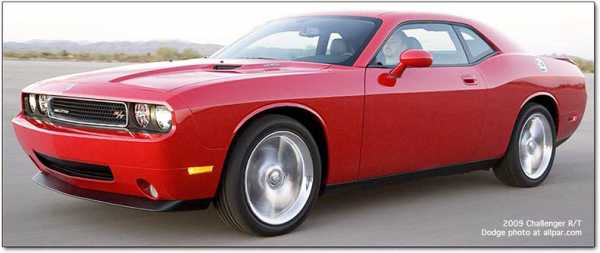
2011-2014 Dodge Challenger • 2015-17 Dodge Challenger cars
When it made its first huge splash, the new Dodge Challenger came in two versions, the everyday SE and the choice where looks matched speed — Dodge Challenger R/T. Power came from a 5.7-liter Hemi V-8 engine — 370 horsepower with a five-speed automatic and mid-grade fuel, 375 hp with the six-speed manual transmission and premium gas.
The Hemi V8 belted out 398 lb-ft of torque (404 lb-ft with manual), and the Challenger R/T could do 0-60 in under six seconds. Gas mileage was not bad for its size and power, with the Hemi getting 16 mpg city, 23 highway (automatic; the manual transmission was 15 city, 23 highway). Without dropping speed, we maintained 27 mpg with the stick on the highway.
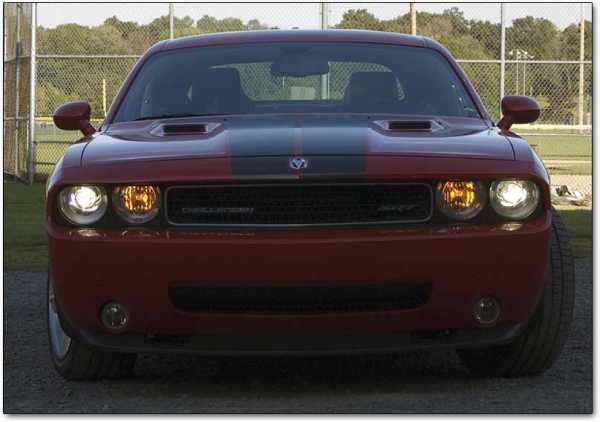
The Challenger SE, with 3.5-liter V-6, was rated at 18/25, but was slower than the bigger Dodge Intrepid R/T had been. A twin-branch tuned intake manifold went from short to long runners for a “supercharging” effect at two engine speed ranges.
The hottest version was the Dodge Challenger SRT8, with its 6.1 liter Hemi V8; available with either the five-speed automatic or Tremec six-speed manual, it did 0-60 in 4.9 seconds, the quarter mile in 13.3, and 0-100-0 in less than 17. Skid-pad results were 0.88g, while braking from 60 mph took just 110 feet, far better than any prior Dodge Challenger.
| 2008-2010 Challengers | Horsepower Torque: lb-ft mpg
| SRT-8 | 425 @ 6200 420 @ 4800
| R/T manual | 375 @ 5,800 404 @ 4,200 15/24
| R/T auto | 370 @5,800 398 @4,200 16/23
| Challenger SE | 250 @ 6,400 250 @ 3,800 17-18/25
The six-speed Tremec TR-6060 manual transmission was derived from the one in the Dodge Viper SRT10, with triple cone synchronizers in first and second gears and dual cone synchronizers for third through sixth gears, along with new gear ratios. The clutch was the Viper’s ZF-Sachs 250 mm twin-disc design, with a 1-4 skip-shift and reverse inhibit solenoids, and a 5:1 remote shifter.
Hill Start Assist (HSA), standard with the manual transmission, held the brake for three seconds to let the driver start up hills more easily, releasing when the system sensed torque. The manual transmission had a dual exhaust with low-restriction bottle resonators replacing the underfloor muffler, and bright pedals.
The manual-transmission Challenger R/T also had a variable displacement power steering pump, different rear shocks, and other tuning changes — and the ability to shut off the ESP completely. Gas mileage was lower than the automatic, due to the lack of cylinder shutoff.
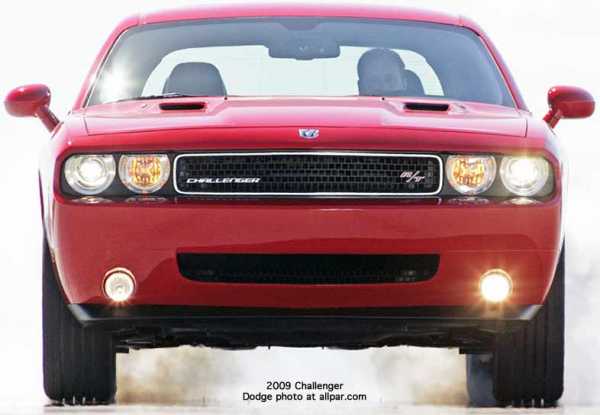
The five-speed automatic (V8) had an aggressive first-gear ratio for launch performance, and AutoStick to select a higher or lower gear. V6 cars carried forward the old four-speed. Gear ratios for each transmission are listed under “specifications.”
The Dodge Challenger convertible
Reliable source “redriderbob” wrote, “Cars were built by Drop Top Customs for Chrysler engineers to see what needed to be done to strengthen the chassis enough to take the roof off the car. Many aftermarket companies, like Prefix, do pre-production engineering with FCA US engineers to build mules, to see if certain things can be done before they are put into production. Unfortunately, the cost was too high to keep the car from being a rattle trap, so the project was scrapped, including the mules, which were destroyed in late 2009 because they don’t have a VIN.”

The company apparently turned to an extremely high-powered stock engine instead — the 707 horsepower Hellcat.
Source oh3o noted that preparations for building a convertible included the front seat belt mounts, mounted ragtop-style instead of being bolted to the B post. That made it easier to make a convertible but less convenient for the driver.
Brakes and suspension
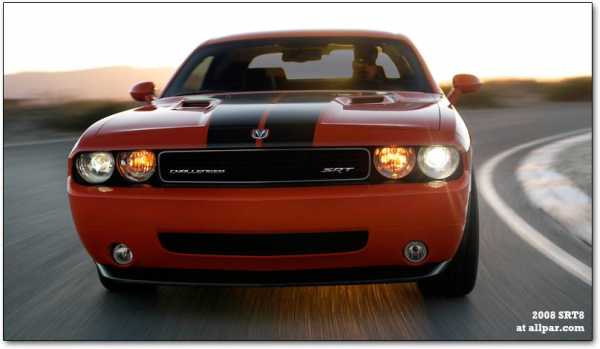
The front suspension was an independent short-long arm design with a high upper A arm, coil spring over gas-charged shocks and stabilizer bar, with lateral and diagonal lower links; the SRT-8 used Bilstein monotube shocks.
The rear suspension was a Mercedes-style five-link independent setup with coil springs, link-type stabilizer bar, shock absorbers, and isolated suspension cradle; the SE and R/T (with automatic) used gas-charged twin shock absorbers, while the SRT-8 used Bilstein monotube gas-charged shock absorbers, and the R/T with manual transmission used gas-charged monotube Nivomat load-leveling shocks. SE did not get the fancy chrome fuel filler door; and the SRT had a half-inch lower ride height. For 2009, SRT engineers fine-tuned suspension settings for both performance tires.
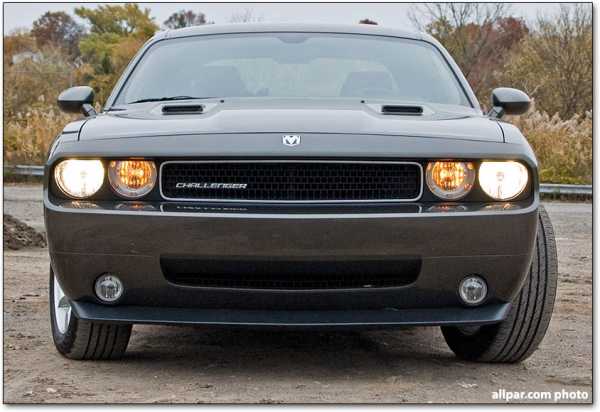
Four-wheel disc brakes were standard. Ducts in the front fascia cooled the front brakes. Each model had different pads.
- SRT8 had Brembo four-piston calipers on all four wheels, for a 60 to zero mph stopping distance of around 110 feet.
- R/T had twin-piston aluminum calipers and vented rotors in the front and single-piston aluminum calipers with vented rotors in the rear, for a 60 to zero mph stopping distance of around 125 feet.
- SE had single-piston aluminum calipers and vented rotors in the front and single-piston aluminum calipers with solid rotors in the rear, stopping from 60 in 130 feet.
Four wheel antilock brakes, traction control, and stability control with brake assist were standard on R/T, SRT8, and, with the Popular Equipment Package, on the SE. The SE’s Popular Equipment Package also had 18-inch aluminum wheels, better tires, an eight-way power driver’s seat, fog lamps, luxury floor mats, leather-wrapped steering wheel and shift knob, security alarm, and dual-illuminated visor mirrors.
The popular equipment package for the R/T had leather, six-speaker stereo with big amp, satellite radio, heated front seats, “luxury floor mats,” keyless ignition, seatback map pocket, automatic headlights, and heated otuside mirrors.
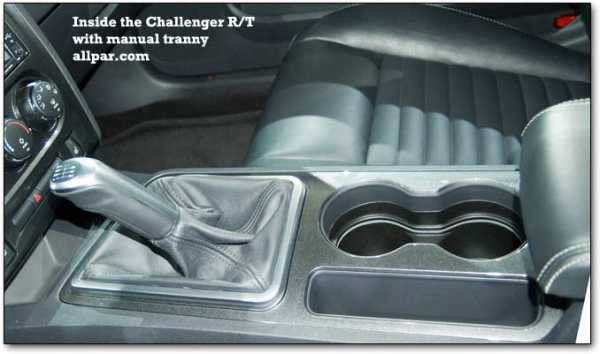
Track Pak included a six-speed manual transmission, Hill Start Assist, anti-spin differential (3.73 w/18-inch, 3.92 w/20-inch wheels), and ESP full-off switch.
Dodge Challenger SRT8
The price for the 2008 Dodge Challenger SRT8 was just under $38,000, including destination. Its performance, according to Chrysler; was:
- 0-60 in 4.9 seconds
- Quarter mile, 13.3 seconds
- Zero to 100 mph and back in under 17 seconds
- Skid pad performance of 0.88 g
The Challenger SRT had a brake-lock differential, all-speed traction control, and specially tuned stability control. The manual transmission cost $695. For 2008, each car had numbered dash plaques.
Inside, the Dodge Challenger SRT8 included leather seats with added bolstering and an orange accent stripe, stitched accents, tachometer, and 180 mph speedometer, with Performances Pages that provided 0–60 mph times, 60–0 mph braking, g-forces, and quarter-mile time. It also included a 13-speaker Kicker audio system with a 322-watt amplifier and 200-watt subwoofer, and satellite radio.
For 2009, the Dodge Challenger SE started at $21,995, while the Challenger R/T started at $29,995, and the SRT-8 started at $39,995. Popular options, according to “CudaAAR,” included a sunroof, $950; MyGIG with GPS, $890; and high-performance tires, $50.
Dodge Challenger in person
The Challenger had an undeniable presence, whether up on a rotisserie, in photos, in video, or in person, and lent itself to “wild” and vibrant colors. Large yellow running lights provided a neat touch of color and a unique look. The full-length tail lit around a single backup-lamp bar.
It is amazing that the designers were able to get approval for the costly full-length tail-lights, the single-bar reverse light, and the real coup de résistance, the separate sidelights (later copied by the Camaro) and dual-headlight-style grille. The main battle, though, was reportedly to get approval for the grille without the trademark Dodge crosshairs.
Christopher Nowak, senior manager of the RWD product team and lead engineer on the Challenger “base car,” enthused about the combination of ride and handling; the SRT8 Challenger was also a better daily driver than past SRT8s, due to new tuning of the suspension.
We found the R/T and SE seats to be comfortable and supportive, with a more classic appearance and less aggressive side bolsters than the SRT8. Getting into the back seat was fairly easy from the passenger side, thanks to the high position of the seatback tilt-n-slide control, though one had to duck under the seat belt (or disconnect it from its seat loop). The driver’s seat had no tilt-and-slide control.
The interior of each model had subtle changes, including pattern changes; the R/T lacked the SRT’s performance metrics, and the SE had a dechromed logo above the glove compartment.
Dodge Challenger Suspension
The Dodge Challenger was a unibody design, as one would expect, with a multilink short and long arm (SLA) front suspension set in a cradle (made of hydroformed steel tube side rails with a stamped box-section lateral member).
The Dodge Challenger SRT8 used a five-link rear suspension; moving from the prior multi-link Chapman strut system reduced the unsprung mass. Decoupling left and right wheels improve tire contact while stabilizer bar attachments to the knuckles reduced lean. For 2008, SRT-exclusive fully-forged 20-inch Alcoa aluminum wheels with 4-season Goodyear Eagle RS-A tires were standard; three-season Goodyear F1 Supercar tires were optional. In both front and rear, multiple links maintained independent control of camber and toe.
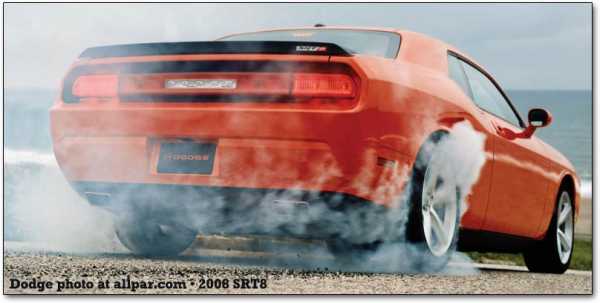
Electronic control and engine torque management were used to smooth full-throttle launches, quicken wide-open-throttle up shifts, and allow two-step kick-down shifts.
All four wheels had red Brembo four-piston calipers, with 360 x 32mm vented rotors up front and 350 x 26mm vented rotors in the rear. When the stability control registers over .6 g, the pads automatically went closer to the discs for instant action.
The drag coefficient of 0.353 (9.01 cdA) was high for a modern car, though similar to the 300C SRT8 (at 0.355).
Dodge Challengers in Canada: SXT, SRT8 500, and more
Canadian buyers had two unique models: the Dodge Challenger SRT8 500 and SXT (thanks, Geo Nazos). The SXT was the SE with an option package. The SRT8 500, only available for 2008, had a certificate of authenticity, carbon fibre hood striples, Kicker 13-speaker audio, 6-disc DVD radio, UConnect, alarm, and badging.
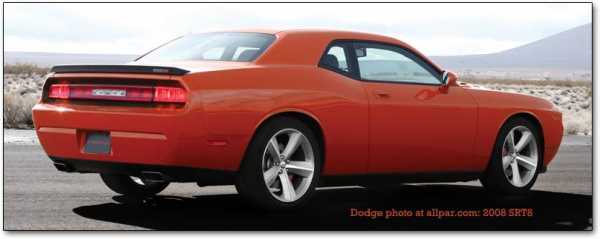
2008 Dodge Challenger styling and such
Jeff Gale, the famed Tom Gale’s son, led exterior design. He said, “We used the original Challenger as an inspiration. The side mirrors actually started with a mold from the mirrors of an original Challenger. We tweaked a few details for fit and finish, then put them through our modern aerodynamic testing metrics and ended up with a body-mounted mirror that is remarkably similar visually to the original, but offers significantly better aerodynamic performance.”
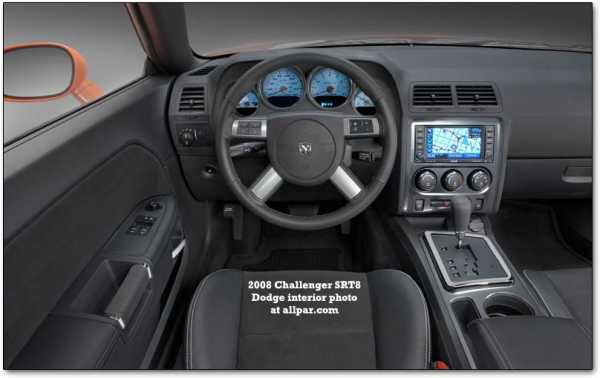
Brian Nielander, manager of design for the Dodge Challenger, wrote that many interior themes were based directly on the original 1970 Dodge Challenger. Inside, the Challenger used the new chrome-ringed climate controls, which are both attractive and functional; the performance indicators were in the lower half of a gauge pod.
The Challenger was built in Brampton, Ontario. Safety devices and such were similar to the Dodge Charger and Chrysler 300C.
Repairs and issues
TSB 18-006-09, dated February 11, 2009, notes that a computer “flash” upgrade is free, under warranty, for customers with 6.1 liter engines and manual transmissions built before February 6, 2009 (MDH 0206xx). This prevents unnecessary engine-light activation for cylinder 7 misfires (P0307) and may prevent the misfires themselves, smoothing the idle.
Some early manual transmission cars fouled the plugs on cylinder #7 (ECM code P0307). The issue appeared to be sensor calibration, and was fixed with a computer update.
Trivia: Stutz had Hill Start Assist (they called it the Noback) in 1929.
Changes
For 2009, the Hemi engine was upgraded to get higher gas mileage and more power, especially at lower engine speeds, via an expanded cylinder cutoff range, increased compression ratio, better port flow, and reduced restriction intake and exhaust. Other updates were crankshaft structural upgrades, a dual-mass crankshaft damper, floating pin piston design, valve spring design, and oil pump capacity increase.
The new-for-2009 Dodge Challenger SE Rallye (starting at $26,490) used the five-speed automatic transmission with the V6. It had 18 inch wheels, a spoiler, chromed fuel door, and faux carbon fiber interior accents, and was the first V6 Challenger to have accented dual stripes, and to step up from a four-speed; it was the first Challenger (in general) to have deck lid stripes. Acceleration was higher than with the SE, but at the cost of 1 mpg (city).
A special-edition Dodge Challenger Classic R/T was sold late in the 2009 model year, with B5 blue paint, black side stripes, unique badging, and 20-inch five-spoke aluminum wheels.
For 2010, the five-speed automatic finally replaced the four-speed across the board, and a deceleration fuel cutoff helped increase mileage at the cost of higher engine braking when it was active. Super Track Pack was an R/T option with the manual transmission. Stability control was standard on all models; automatic headlights with LED cup holder and door-handle lights were standard on R/T. Changes to the Challenger SRT8 were new limited edition Plum Crazy and Furious Fucshia models, serialized dash plaque, and plum accent seat-stripe insert.
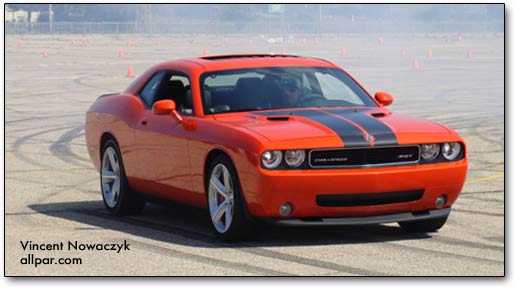
The Hemi had a six-speed manual option which achieved the same gas mileage as the automatic. There were also a late-availability Super Track Pack option for R/T, UConnect multimedia with Sound Group I and II, steering wheel audio controls with Multimedia and Navigation, standard stability control on SE, and automatic headlights with LED cup holder and door-handle lights standard on R/T.
The long-rumored 475 hp 6.4 liter engine with cylinder deactivation showed up for SRT, midyear.
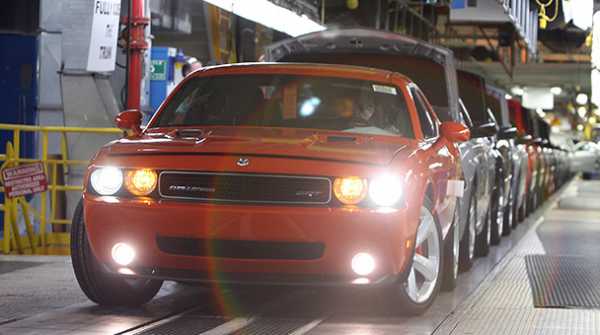
The Brampton facility made the Dodge Challenger, Dodge Charger, and Chrysler 300C on one line. Forty-two robots were added in the Body Shop to weld the Challenger’s unique body sub-assemblies.
Pre-production cars were built and tested on the regular assembly line, without interfering with production. Flexible manufacturing of this type was first used in the launch of the 2001 minivans.
Special Dodge Challengers
We have separate sections on the
Keep going ->
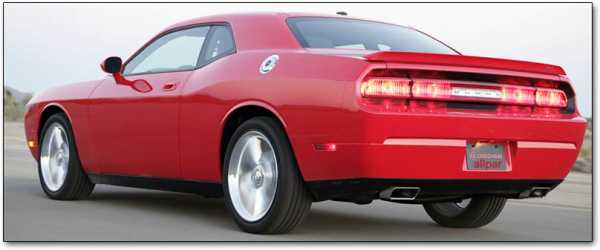
Thanks to oh30 for years of on-target predictions!
2008-2010 Dodge Challenger cars, including the SRT8, Classic, and Challenger R/T
The Hellcat’s little brother can still run with the big boys
Between the fervor caused by the supercharged, 707-horsepower SRT Hellcat and the revelation that nearly 500 ponies can be had for less than $40k by opting for an R/T Scat Pack, the SRT 392 has become something of a neglected middle child in the Challenger lineup. It more or less splits the difference between the two in terms of features, looks, performance, and price. In our 2017 Dodge Challenger SRT 392 review, however, we found that instead of being too hot or too cold, the SRT is just right for the right buyer.
While the shadow of its boosted brethren looms large and the less expensive alternative offers identical power output, the SRT 392 is a compelling option in its own right, boasting the grip, braking, and similar suspension components to its top-spec SRT counterpart but with a noticeable amount of weight taken off of the front of the car and cost removed from the bottom line.
And although it shares a power plant with the Scat Pack model, the upgrades here go beyond standard equipment like the 900-watt audio system and leather seating. But is it worth the premium over the Scat Pack? And on the other end of spectrum, does the SRT 392 fall short of greatness simply because it’s not an SRT Hellcat? We grabbed the keys to our B5 Blue, six-speed manual transmission-equipped tester and hit the streets of Los Angeles to find out.
The anatomy of an SRT 392
The 2015 refresh of the Challenger lineup created some convolution as a result of its model expansion. Both the R/T and SRT trim levels gained a new model whose configuration was substantially different from the other model it shared a badge with, and the news Challenger T/A adds another level of complexity when it comes to discerning what model gets what hardware.
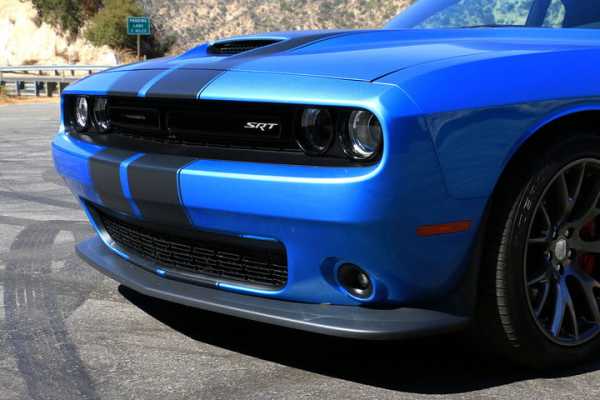
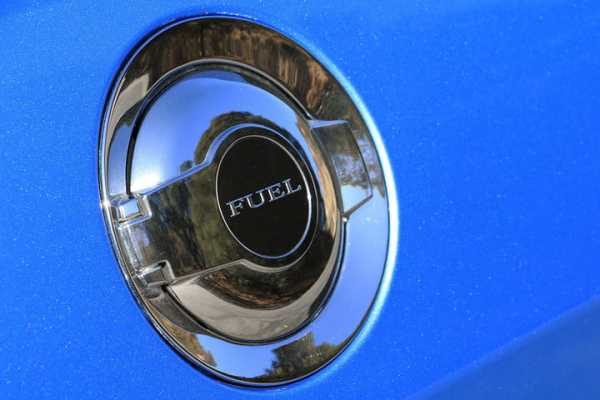
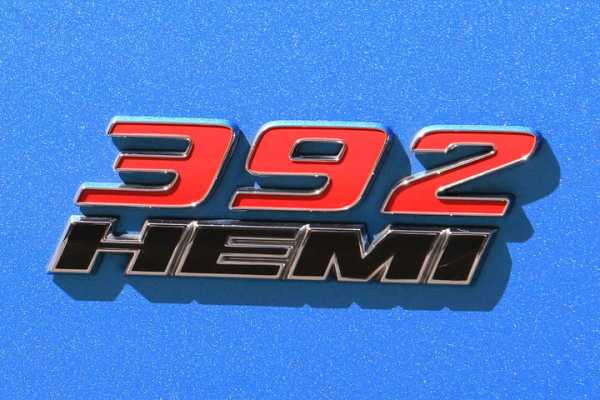
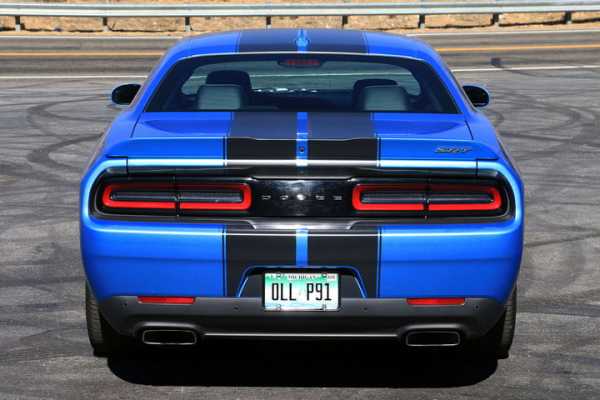
For the SRT 392’s part, the most obvious element is the 392 cubic-inch, 6.4-liter naturally aspirated V8, which makes 485 hp and 470 pound-feet of torque. It is essentially identical to the 6.4-liter motor used in the R/T Scat Pack model, as indicated by its identical power output. And like the Scat Pack, the SRT 392 is available with a six-speed manual gearbox or an eight-speed automatic with paddle shifters. But the devil’s in the details when it comes to comparing these two. For instance, while the two cars offer six-speed manual transmissions, we noticed that the clutch resistance in the SRT model is similar to the Hellcat rather than the relatively light action in the R/T Scat Pack.
In terms of luxury content, the SRT 392 is every bit the grand tourer that the SRT Hellcat is.
Other differences are more obvious though – while the Scat Pack model gets a static spring and Bilstein damper suspension setup, the SRT 392 uses a Hellcat-like three-mode adaptive system which allows occupants to alter ride stiffness on the fly from the infotainment display. The system functions in the same manner as it does in the SRT Hellcat, but it’s clear the SRT 392’s tuning is not nearly as aggressive as the Hellcat’s. The ride height is slightly higher, the springs slightly softer, and the sway bars are slightly less substantial. While it’s still undoubtedly a sport-tuned setup, the components used differ from those in the SRT Hellcat.
Braking, however, does not. The SRT 392 gets the same meaty six-piston Brembo brakes that its more expensive counterpart does, and its available wheel and tire combination is the same as well, sans the wheels’ paint hue. With less mass over the front end of the car the 392’s weight distribution is more ideal than the Hellcat’s, and the lower weight means the brakes have an easier job slowing down the car.
Steering is something of a mixed bag – while the SRT Hellcat sticks with a hydraulically-assisted rack, both the R/T Scat Pack and SRT 392 use an electronically boosted one. Although there’s a small sacrifice in steering feel, the consolation prize is the ability to adjust steering weight on the lesser models, a feature that can’t be designed into a hydraulic rack.
2017 Dodge Challenger SRT 392 Compared To
In terms of luxury content, the SRT 392 is every bit the grand tourer that the SRT Hellcat is. Heated and ventilated leather seating, a leather-trimmed, flat-bottomed steering wheel, and the 8.4-inch Uconnect infotainment system with navigation and SRT Performance Pages functionality are standard here as they are in the SRT Hellcat, and this luxury content is another area where the SRT 392 clearly differentiates itself from the R/T Scat Pack.
Behind the wheel
One of the numerous improvements made in the 2015 refresh was the switch to active exhaust systems for all performance models from the R/T Scat Pack on up. So as you’d expect, the SRT 392 sounds the business when you fire up that big Hemi. However, that middle child syndrome hits a snag here as well.
For those that have never had seat time in a Hellcat, the SRT 392’s engine note is the stuff that muscle car dreams are made of. But those fortunate enough to have spent some time in the supercharged model will notice the difference. While the 392 sounds like a proper V8 bruiser in its own right, it lacks the guttural violence of the Hellcat which, quite honestly, sounds more like something that you’d see rounding Daytona Speedway than cruising down Main Street.
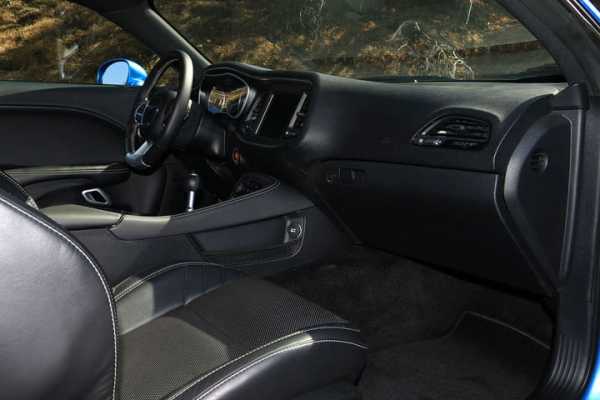
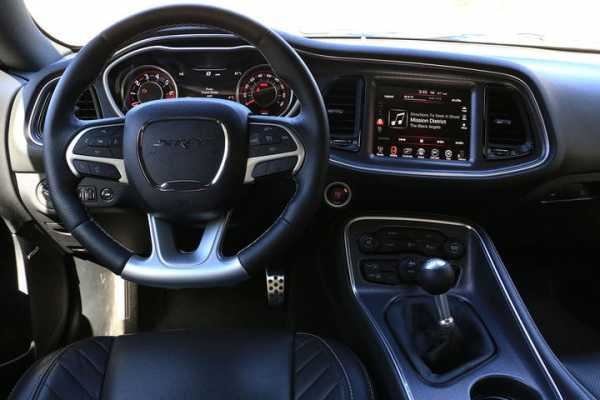
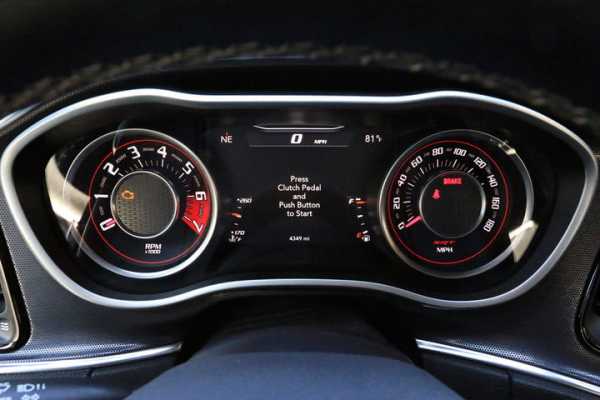
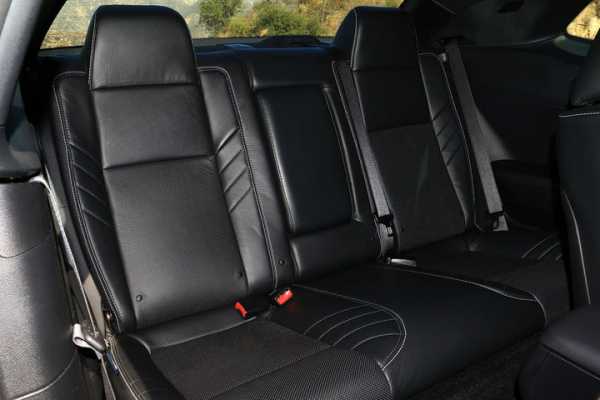
The same goes for the SRT 392’s performance. Sprinting to 60 mph from a standstill in just over four seconds is legitimately quick by production car standards, but the Hellcat’s mid three-second gallop puts it in league with six-figure supercars. Truth be known, you’d be hard pressed to find areas to really utilize 707 hp outside of a race track, so the SRT 392’s 222-hp deficit isn’t that much of a concern during normal driving.
Compared to well-equipped iterations of the Mustang GT and Camaro SS, the SRT 392 boasts both more grunt and more luxury, but the LX architecture that underpins the Challenger is both dimensionally larger than those two and fairly ancient from a technological standpoint. While the Challenger will hold off the Ford and Chevy in straight line sprints, its additional weight and sedan-based chassis – while admirably capable and a lot of fun to toss around – can’t muster up the same level of handling prowess. It’s just physics, man.
The road ahead
Challenger owners are most likely to replace their car with another Challenger.
Although the Challenger’s LX-based platform limits the car’s dynamics to some extent, it’s also a huge factor in the coupe’s chiseled good looks and grand touring comfort. The rumor mill speculates that the next big step for the Challenger will be a move to a new platform that it will again share with the Charger, based on the significantly smaller Alfa Romeo Giulia. If the rumor proves true it would bring the Challenger closer to the sixth-generation Camaro in size, and likely improve some of its dynamic limitations in the process.
But it’s also likely to come at the cost of the cavernous trunk, rear seats that adults can actually sit in, and a general lack of claustrophobia. One of FCA’s coveted talking points is that Challenger owners are most likely to replace their car with another Challenger, showing how fiercely loyal this big coupe’s fans are. You have to wonder if that passion will remain if this outlier muscle car’s design finally falls in line with the trends in rest of industry.
Safety
The National Highway Traffic Safety Administration (NHTSA) doesn’t provide a rating for the Challenger SRT. However, the non-SRT model earned a five-star overall rating. Every Challenger SRT comes standard with front, curtain, and side airbags in addition to electronic stability control, rain brake support, brake assist, and a rearview camera.
How DT Would Outfit This Car
Here’s how we’d order our Dodge Challenger SRT. We liked the manual transmission on our tester so we wouldn’t pay an extra $1,500 for the automatic. Instead, we’d spend that money on a sunroof and on the Technology Package, which adds goodies like rain-sensing wipers. Finally, we’d order the Yellow Jacket paint and get the twin black center stripes. Our ideal Challenger SRT would cost $51,580.
Our TakeOne thing is for certain: If muscle cars are your thing, nobody is doing it with more sincerity than Dodge is right now, for better and for worse. And although it’s not quite the king of the hill, the SRT 392 brings enough charisma, value, and capability to make a strong case for itself on any performance coupe shopping list.
Is there a better alternative?
The Challenger’s main challengers are the Ford Mustang and the Chevrolet Camaro. Both rivals are built on more modern platforms, they’re smaller, and they’re also more dynamic to drive. If carving corners is a priority, look at the other pony cars. If you want an old-school muscle car with a huge engine without spending Hellcat money, the SRT 392 is the way to go.
How long will it last?
The Dodge Challenger is nearing the end of its life cycle — hypothetically, at least. Dodge keeps models on the shelf for longer than its rivals, and it has an impressive history of delaying new product launches. With that said, the current model will stay fresh in the foreseeable future because we don’t expect to see a brand-new Challenger until 2019.
Should you get one?
From its engine to its heritage paint colors, the Dodge Challenger channels the spirit of 1960s muscle cars better than any other model on the market today. It’s no secret that upcoming government regulations will make it difficult for car makers to build big, sporty coupes equipped with a large-displacement engine that generate power without hybrid assistance. Pull the trigger, just in case the Challenger’s genus is headed towards extinction.
Update: We’ve updated our Challenger SRT 392 review to reflect the changes made for the 2017 model year. We’ve added information on safety tech and customization options for 2017.
"Питер - АТ"
ИНН 780703320484
ОГРНИП 313784720500453

